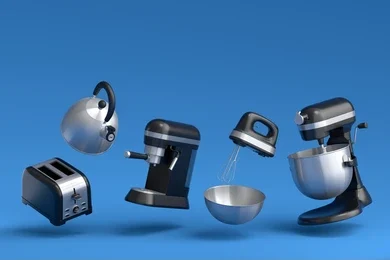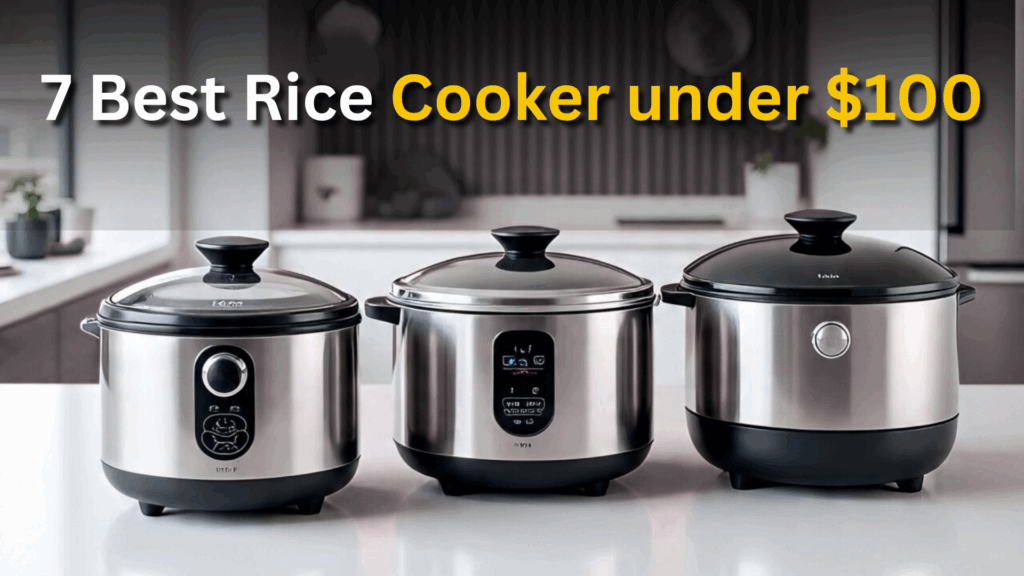Why this guide — and who it’s for
If you’re new to home espresso you want a machine that’s forgiving, easy to use, and capable of good results without years of barista training. Some beginners want a simple one-touch experience (capsule or automatic machines), others want a low-cost semi-automatic to learn with, and some want a compact machine with a real steam wand for milk drinks. This guide covers machines across that spectrum but focuses on beginner-friendliness: ease of use, reliability, cleaning, and value.
Below are 7 Espresso Machines for Beginners that perform well for beginners and are available on Amazon. I include detailed notes on what to expect, how to use each machine, and where beginners typically struggle — plus real Amazon product links so you can inspect current prices and add your affiliate tracking.
How I picked these Espresso Machines for Beginners
I prioritized machines that:
- Are readily available on Amazon
- Offer beginner-friendly features (pressurized baskets / assisted milk frothing / one-touch options).
- Represent a range of price points and styles: semi-automatic, super-automatic, and capsule.
- Have consistent user feedback (good starter experience) and brand support.
In-depth reviews — Top 7 Espresso Machines for Beginners (each machine fully covered)
The 1st Espresso Machines for Beginners De’Longhi Stilosa EC260BK — Best budget semi-automatic starter machine
Why beginners like it
The De’Longhi Stilosa is one of the most accessible semi-automatic espresso machines for newcomers: it gives you a true espresso workflow (portafilter, single/double filters, steam wand) but keeps controls simple. It’s compact, inexpensive, and easy to maintain — ideal if you want to learn extraction and milk frothing without a big investment.
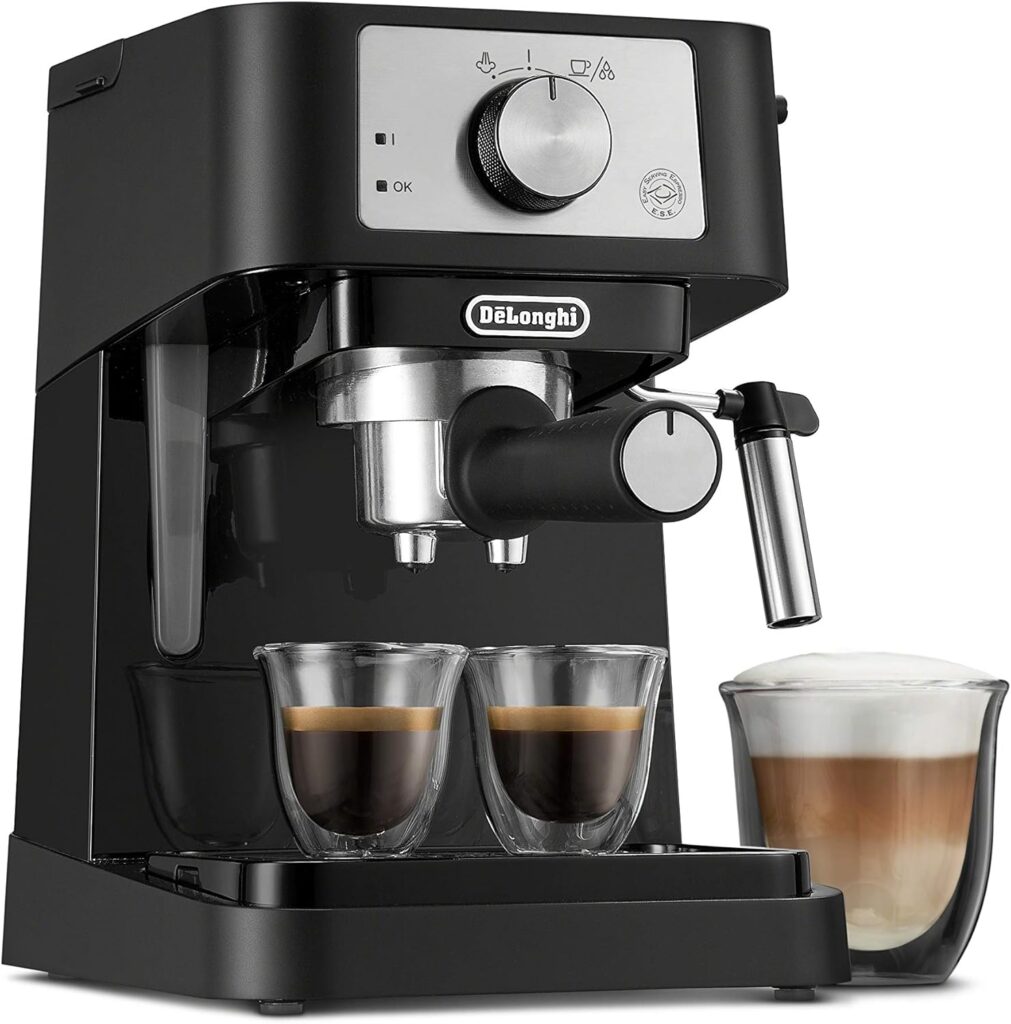
Key specs & features
- 15-bar pump pressure (commercial-style pump).
- Manual steam wand for milk frothing.
- Single and double shot filter baskets included.
- Compact footprint for small kitchens.
Detailed performance (what to expect)
- Espresso quality: With fresh beans and a proper grind, the Stilosa can produce a pleasant shot with crema comparable to entry-level machines. Expect to spend some time dialing in grind and dose — but the machine rewards practice.
- Milk frothing: The manual steam wand gives real control but requires practice to produce microfoam. Beginners can achieve cappuccinos and lattes with patience.
- Heating & recovery: Warm-up time is moderate — preheat the portafilter and group head for best consistency.
- Build & durability: Mostly plastic with stainless accents. Durable enough for home use but not built for heavy daily commercial loads.
User tips
- Buy a small, inexpensive burr grinder (fresh grind > preground).
- Use a tamper with consistent pressure (approx. 20 kg force) and level the puck.
- Purge steam wand before and after each use, and wipe it immediately.
Pros
- Real semi-automatic experience at a low price.
- Compact & simple controls.
- Includes single & double filters — good for learning.
Cons
- Manual steam wand has a learning curve.
- Plastic construction in some parts (not premium).
- Smaller water reservoir than some larger machines.
The 2nd Espresso Machines for Beginners is De’Longhi Dedica (EC685 / EC685M) — Slim semi-automatic with good usability
Why it’s a top beginner pick
The Dedica line is famous for being compact while offering consistent performance and a professional-looking portafilter. It’s slightly more advanced than the Stilosa, has a slim profile that fits tight counters, and includes features that make it simple for beginner baristas while offering room to grow.
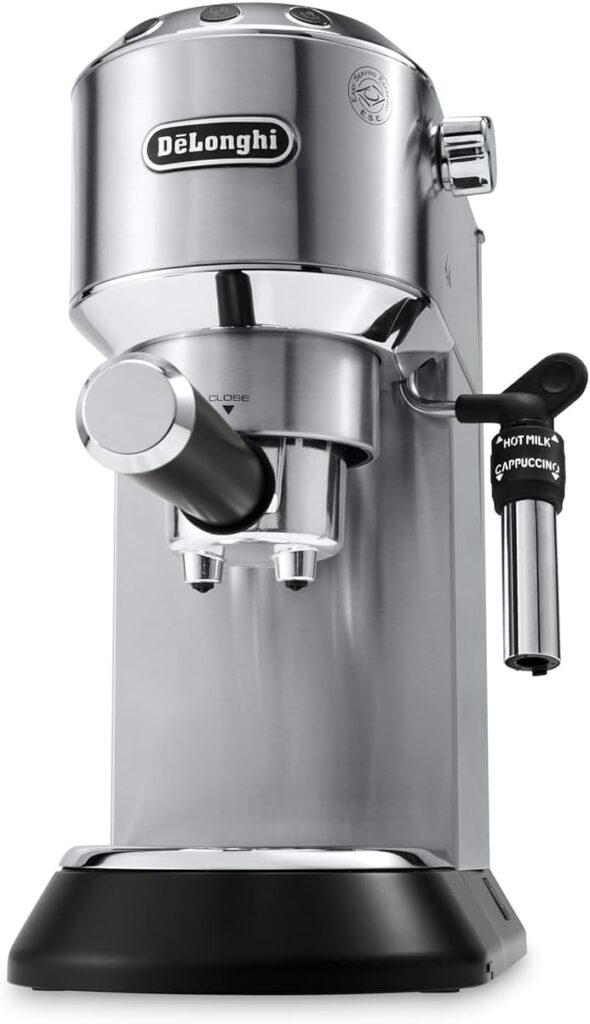
Key specs & features
- 15-bar pump.
- Slim 6-inch width (designed for small kitchens).
- Manual steam wand for milk texturing.
- Adjustable drip tray for larger cups.
Detailed performance
- Espresso extraction: The Dedica handles a consistent extraction when paired with a decent grinder. You’ll get clear crema and good flavor with correct grind and tamp.
- Milk performance: The steam wand produces heat and workable microfoam; practice is still necessary to make latte art, but the Dedica makes good cappuccinos for beginners.
- Ergonomics & build: Mostly metal facings with quality feel; the slim design is perfect for small apartments.
User tips
- Use medium-fine grind for best extraction; too coarse = under-extracted, too fine = slow drip.
- Warm the machine and portafilter; preheat your cup for better temperature retention.
Pros
- Attractive design and compact footprint.
- Good consistency and better build feel than entry-level cheap machines.
Cons
- Still manual steam wand — practice required.
- Not a built-in grinder; costs add up if you buy a separate grinder.
The 3rd Espresso Machines for Beginners is Breville Bambino Plus (BES500) — Fast heat & advanced features for beginner-to-intermediate
Why beginners who want pro features choose it
Breville’s Bambino Plus gives beginner users professional-grade support without complex menus: fast heat (ThermoJet heating), automatic steam wand with temperature control, and consistent extraction. It’s compact but has features found in higher-end machines, making it a favorite for beginners who want to invest a little more for speed and superior milk texture.
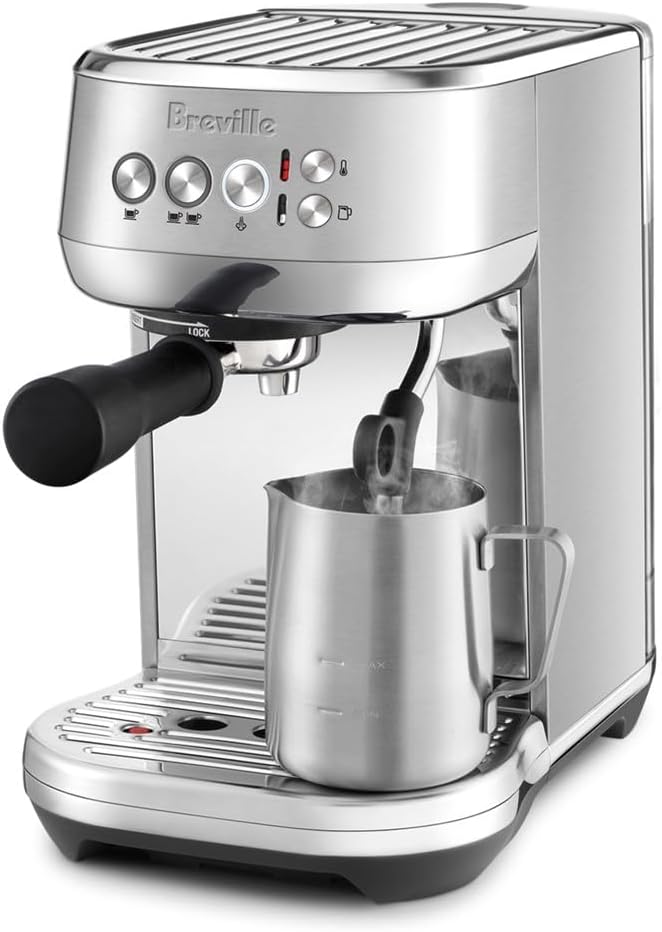
Key specs & features
- ThermoJet rapid heat system (fast heat up, ~3 seconds to reach extraction temp).
- Automatic steam wand that textures milk to a set temperature (beginner-friendly).
- 54 mm portafilter (professional size).
- Compact build and quick recovery.
Detailed performance
- Espresso shots: Strong and consistent once you dial the grind and dose. The 54 mm portafilter improves stability and puck extraction compared to smaller consumer baskets.
- Milk texture: The automatic steam function reliably produces microfoam for lattes and cappuccinos, greatly reducing the learning curve.
- Reliability: Breville builds are typically robust; machine maintenance (descale, clean) is straightforward.
User tips
- Even with auto-steam, practice milk swirling and tapping to achieve silky texture.
- A decent grinder (e.g., Baratza entry model) pairs exceptionally well with the Bambino.
Pros
- Fast heat up and consistent steam.
- Auto steam wand lowers the skill barrier for great milk drinks.
- Solid build and professional portafilter size.
Cons
- More expensive than basic beginners’ machines.
- No built-in grinder — buy a grinder if you want the best shots.
The 4th Espresso Machines for Beginners is Gaggia Classic / Classic Pro — The durable prosumer option that grows with you
Why choose the Gaggia Classic family
Gaggia Classic (and the Classic Pro / Evo variations) are frequently recommended as the best “first serious espresso machine” for people who want longevity and upgrade potential. It’s more of a prosumer machine — more metal parts, commercial-style portafilter, and excellent steam — so beginners who intend to learn and upgrade their technique love it.
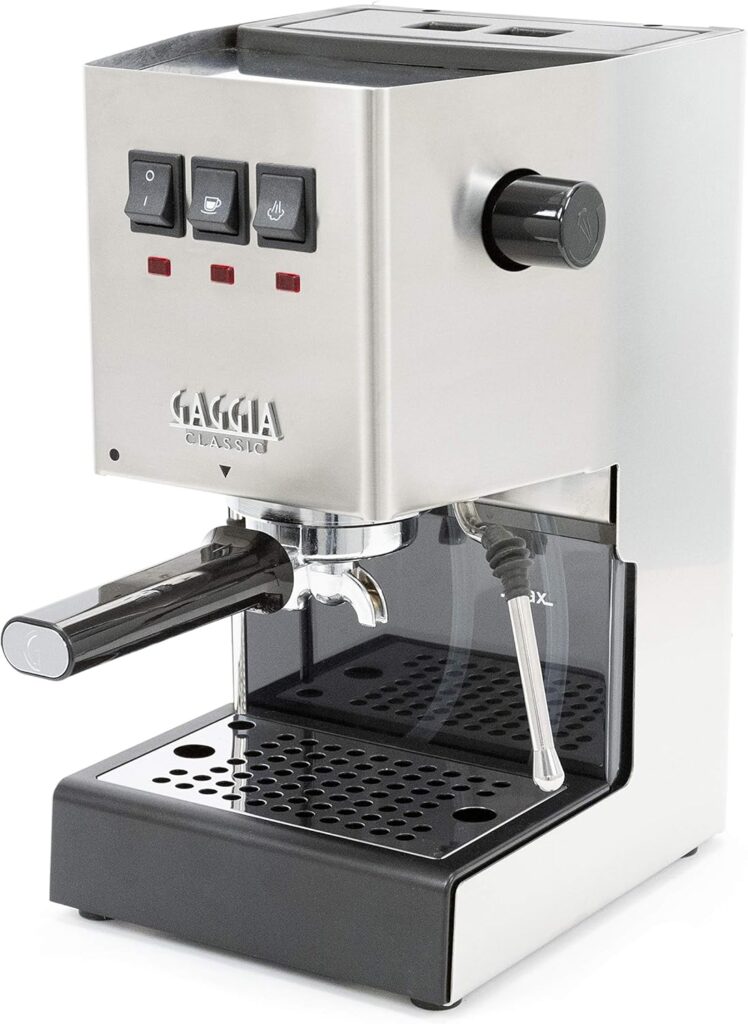
Key specs & features
- Commercial-style 58 mm portafilter (varies by model evolution).
- Durable housing and commercial components.
- Powerful steam wand for milk texture.
- Repairable and many aftermarket parts available.
Detailed performance
- Espresso quality: With a good grinder, the Gaggia yields superb shots and offers the control needed to learn. It rewards users who learn dosing, grinding, and tamping.
- Milk performance: The steam wand is capable of creating excellent microfoam (with practice), making it ideal if you want to master milk drinks.
- Durability & serviceability: Built to be repaired and serviced, with a strong owner community for mods and upgrades.
User tips
- This is a machine that invites upgrades: a PID controller, better steam tips, or a commercial portafilter are common add-ons.
- Use medium-fine grind and practice dosing — the Gaggia responds well to small tweaks.
Pros
- Built like a tank; great long-term investment.
- Excellent steam and shot potential once you learn technique.
Cons
- Heavier learning curve compared with super-automatics or capsule machines.
- Larger footprint and a higher initial price than entry mini-machines.
The 5th Espresso Machines for Beginners is Philips 3200 Series with LatteGo — One-touch super-automatic for fuss-free milk drinks
Why beginners love super-automatics
If you want great milk-based drinks at the push of a button without worrying about grinding, tamping, or steaming, a super-automatic will save you time. The Philips 3200 Series uses a built-in grinder and the LatteGo milk system to produce lattes and cappuccinos with minimal manual input — great for people who prefer convenience and consistent results.
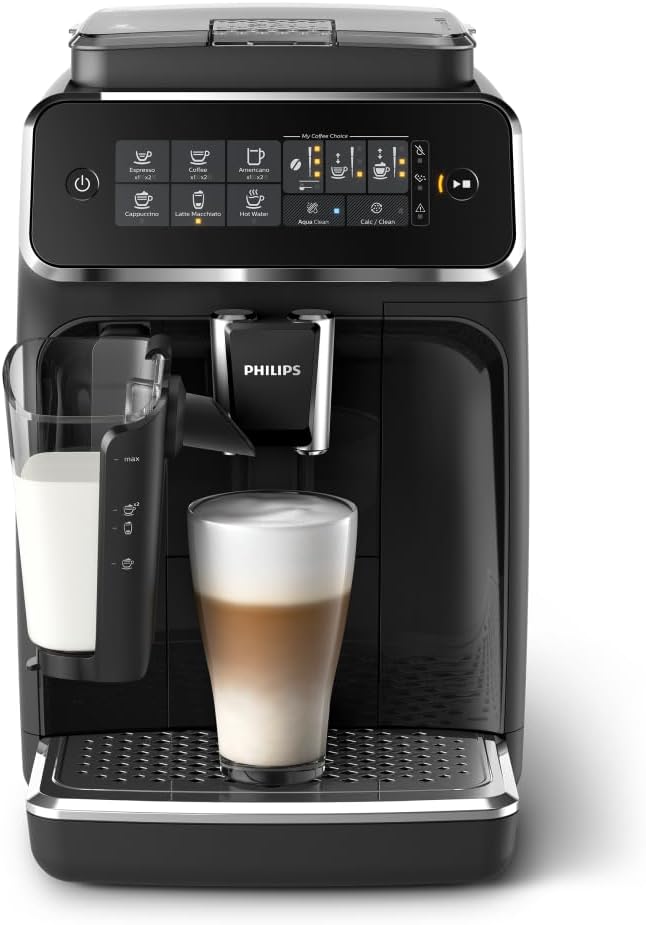
Key specs & features
- Built-in ceramic burr grinder with multiple grind settings.
- LatteGo milk system (easy to clean).
- Touch display with presets for different drinks (espresso, Americano, cappuccino, latte, iced coffee).
- AquaClean filter (reduces descaling frequency).
Detailed performance
- Consistency: Super-automatics deliver consistent drinks once you program preferences (strength, cup size, temperature). This makes them ideal for busy households.
- Milk texture: LatteGo does an excellent job creating smooth foam without handling a wand — one of the easiest systems to clean.
- Maintenance: You’ll still need to clean and descale, but the modular design and LatteGo ease daily upkeep.
User tips
- Use whole beans with a medium roast for best results; experiment with grind settings to adjust extraction.
- Clean milk parts after every use to avoid buildup and flavor issues.
Pros
- Minimal learning curve — great one-touch drinks.
- Built-in grinder and easy milk cleaning system.
Cons
- Less hands-on control (not ideal if you want to master tamp/grind techniques).
- Higher upfront cost vs simple semi-auto machines.
The 6th Espresso Machines for Beginners is Nespresso Vertuo Next — Capsules with variety & strong crema
Why beginners should consider capsules
Capsule machines (Nespresso) remove almost all variables: premeasured, hermetically sealed coffee for consistent shots. The Vertuo line brews several sizes (espresso to larger coffee) and uses barcode recognition to adjust brewing parameters. For a beginner who wants convenience, speed, and consistent crema, Vertuo is a great choice.
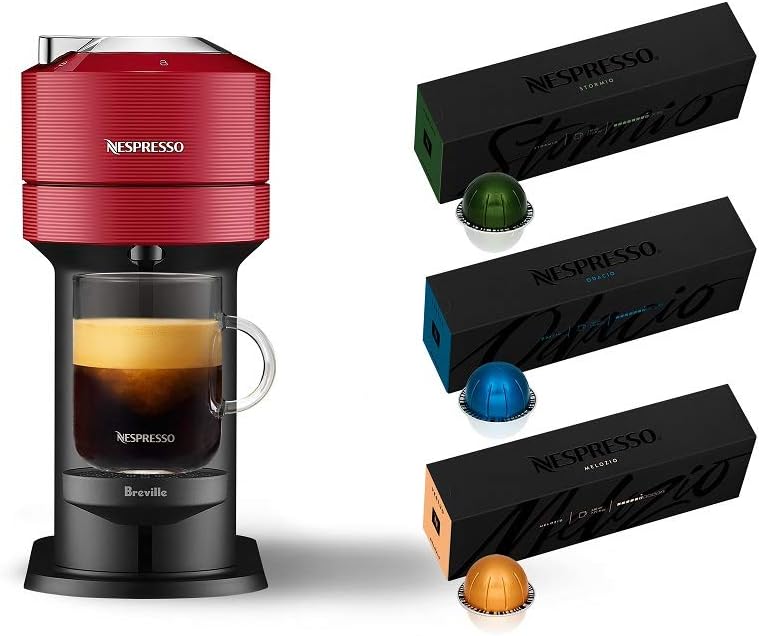
Key specs & features
- Uses Nespresso Vertuo capsules (wide variety of blends & sizes).
- Centrifusion extraction and barcode reading for optimized brew profiles.
- Quick heat up and compact footprint.
Detailed performance
- Consistency & crema: The Vertuo line is known for producing reliable crema and multiple cup sizes with just one button press. (Amazon)
- Taste & variety: Nespresso offers many capsules tuned for different strengths and tasting notes. This is great for beginners experimenting with flavor profiles without buying many whole-bean bags.
- Costs: Capsules are more expensive per cup than beans, but the convenience is the tradeoff.
User tips
- Try a sampler pack to find your preferred capsule varieties.
- Buy in bulk during deals to reduce per-cup cost.
Pros
- Extremely easy and fast; near-zero learning curve.
- Wide range of capsule flavors & sizes.
Cons
- Ongoing cost of capsules is higher than beans by volume.
- Less control over the shot (no tamp/grind control).
The 7th Espresso Machines for Beginners is Nespresso Inissia (OriginalLine) — Cheapest path to consistent espresso shots
Why it’s a beginner favorite
The Nespresso Inissia is among the most affordable ways to get consistent short espresso shots at home. It’s simple, compact, and pairs with a wide range of OriginalLine capsules. For total beginners who want straightforward espresso without the fuss of grinding or tamping, it’s a solid pick.
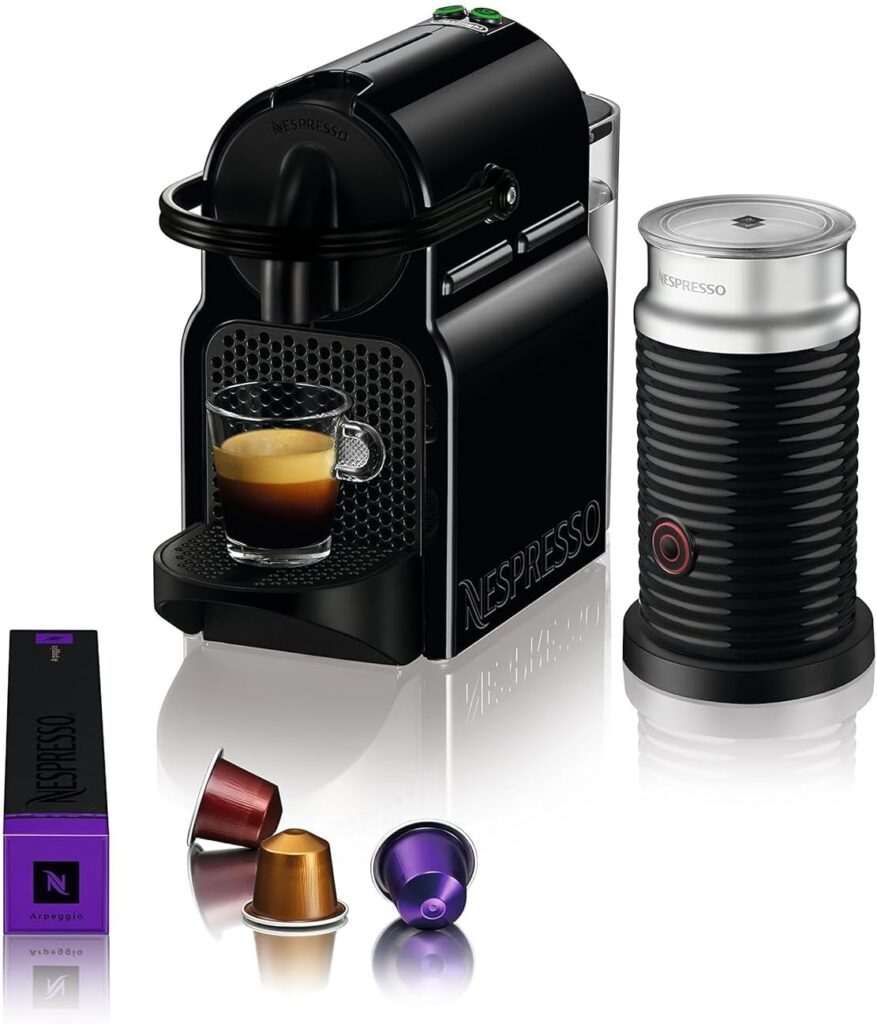
Key specs & features
- Fast heat-up, small footprint, programmable cup buttons.
- Uses Nespresso OriginalLine capsules (esp. strong espresso blends).
- Very affordable initial price.
Detailed performance
- Shots: Consistent and quick — expect café-style single espressos that are reliable.
- Milk drinks: Pair with a separate Aeroccino milk frother for cappuccinos or lattes (sold separately or in bundles).
- Maintenance: Very low — just empty capsule container and rinse milk frother.
User tips
- Buy a sample pack of OriginalLine capsules to test varieties.
- If you prefer milk drinks, consider bundles with Aeroccino for simple frothing.
Pros
- Lowest learning curve — press button, get espresso.
- Very compact and affordable.
Cons
- Capsule cost and environmental footprint (consider recycling programs).
- Less control and fewer cup size options than Vertuo (OriginalLine focuses on espresso).
Buyer’s Guide — How to choose the best beginner espresso machine for you
This section explains the practical decisions beginners face and how to weigh them.
1. Decide how hands-on you want to be
- Capsule / Super-automatic (Nespresso, Philips 3200): Minimal effort, consistent results, little technique needed. Best if you want convenience.
- Semi-automatic (De’Longhi Stilosa, Dedica, Breville Bambino): Gives you control over grind, dose, and tamp — great for learning and improving.
- Prosumer (Gaggia Classic): Best if you’re committed to learning and potentially upgrading components.
2. Budget
- Entry capsule machines and entry semi-autos can be very cheap. Mid-range semi-autos (Breville, Dedica) cost more but offer better steam and durability. Super-automatics cost more initially but save time.
3. Counter space & capacity
- Measure your space. Some machines (Dedica, Stilosa, Bambino) are compact; Gaggia and Philips are wider/taller.
4. Milk drinks?
- If you drink milk drinks daily, consider a machine with either a reliable steam wand (Gaggia, Breville) or an easy-to-use milk system (Philips LatteGo, Breville auto steam).
5. Grinder considerations
- A good grinder is often the single best upgrade. Even the best machine cannot compensate for poor grind. If you choose a machine without a built-in grinder, factor a grinder into your budget.
6. Maintenance
- Super-automatics need descaling and cleaning but put less skill demand on you daily. Manual machines require regular group head and wand cleaning.
7. Warranty & support
- Choose brands with reliable support and an available parts ecosystem (De’Longhi, Breville, Gaggia, Philips).
How to get great espresso quickly (practical beginner checklist)
- Use fresh whole beans, grind just before brewing.
- Aim for a dose of ~18–20 g for double shot (check your machine’s filter size).
- Use a good burr grinder — entry models like Baratza Encore are common recommendations.
- Preheat machine and portafilter. Warm your cup.
- Pull a shot of ~25–30 seconds (adjust grind if too fast/slow).
- For milk drinks: start with cold milk, purge the wand, and practice texture with brief 10–20 sec bursts.
- Clean steam wand immediately after each use.
Pros & Cons summary (for all types)
Capsule / Super-Automatic Pros
- Fast, consistent, easy to use.
Capsule / Super-Automatic Cons
- Higher per-cup cost (capsules); less hands-on control.
Semi-Automatic Pros
- Hands-on control, upgrade path, better learning potential.
Semi-Automatic Cons
- Steeper learning curve, need for grinder and technique practice.
Final recommendations of Espresso Machines for Beginners — Which one should you buy?
- Total beginners who value convenience: Nespresso Vertuo Next or Inissia (capsule machines). Quick, consistent, minimal cleanup.
- Beginners who want to learn and make real espresso: De’Longhi Stilosa (budget) or Dedica (compact & refined) are excellent starting semi-autos.
- Beginners who want the best balance of speed & quality: Breville Bambino Plus — fast, consistent shots and very good automatic milk texture.
- If you want to commit & grow: Gaggia Classic is a long-term machine with upgrade potential.
- If you want one-touch milk drinks & minimal effort: Philips 3200 LatteGo is great for daily convenience and milk drink lovers.
Frequently asked questions (FAQ)
Q: Do I need a grinder?
A: For the best espresso from a semi-automatic machine, yes. Freshly ground beans matter more than many other factors. For capsules and many super-automatics, the grinder is built-in or unnecessary.
Q: What about maintenance costs?
A: All machines require routine cleaning and periodic descaling. Capsule machines require fewer technical maintenance steps but need capsule purchases. Super-autos often require more care for the milk system.
Q: Can I learn latte art on a beginner machine?
A: Yes — machines with capable steam wands (Breville Bambino Plus, Gaggia, Dedica) allow you to learn microfoam and basic latte art with practice.
Affiliate disclosure
Some of the links in this article go to Amazon product pages and are affiliate links. If you click through and make a purchase I may earn a small commission at no extra cost to you. I only recommend products I believe provide value or utility. Always check current price, shipping details, and return policy on Amazon before purchasing. )
